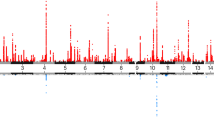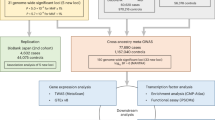Abstract
Atrial fibrillation (AF) is the most common sustained arrhythmia. Previous studies have identified several genetic loci associated with typical AF. We sought to identify common genetic variants underlying lone AF. This condition affects a subset of individuals without overt heart disease and with an increased heritability of AF. We report a meta-analysis of genome-wide association studies conducted using 1,335 individuals with lone AF (cases) and 12,844 unaffected individuals (referents). Cases were obtained from the German AF Network, Heart and Vascular Health Study, the Atherosclerosis Risk in Communities Study, the Cleveland Clinic and Massachusetts General Hospital. We identified an association on chromosome 1q21 to lone AF (rs13376333, adjusted odds ratio = 1.56; P = 6.3 × 10−12), and we replicated this association in two independent cohorts with lone AF (overall combined odds ratio = 1.52, 95% CI 1.40–1.64; P = 1.83 × 10−21). rs13376333 is intronic to KCNN3, which encodes a potassium channel protein involved in atrial repolarization.
This is a preview of subscription content, access via your institution
Access options
Subscribe to this journal
Receive 12 print issues and online access
$209.00 per year
only $17.42 per issue
Buy this article
- Purchase on SpringerLink
- Instant access to full article PDF
Prices may be subject to local taxes which are calculated during checkout


Similar content being viewed by others
Accession codes
References
Fuster, V. et al. ACC/AHA/ESC 2006 Guidelines for the Management of Patients with Atrial Fibrillation: a report of the American College of Cardiology/American Heart Association Task Force on Practice Guidelines and the European Society of Cardiology Committee for Practice Guidelines (Writing Committee to Revise the 2001 Guidelines for the Management of Patients With Atrial Fibrillation): developed in collaboration with the European Heart Rhythm Association and the Heart Rhythm Society. Circulation 114, e257–e354 (2006).
Jahangir, A. et al. Long-term progression and outcomes with aging in patients with lone atrial fibrillation: a 30-year follow-up study. Circulation 115, 3050–3056 (2007).
Ellinor, P.T., Yoerger, D.M., Ruskin, J.N. & MacRae, C.A. Familial aggregation in lone atrial fibrillation. Hum. Genet. 118, 179–184 (2005).
Fox, C.S. et al. Parental atrial fibrillation as a risk factor for atrial fibrillation in offspring. J. Am. Med. Assoc. 291, 2851–2855 (2004).
Arnar, D.O. et al. Familial aggregation of atrial fibrillation in Iceland. Eur. Heart J. 27, 708–712 (2006).
Gudbjartsson, D.F. et al. Variants conferring risk of atrial fibrillation on chromosome 4q25. Nature 448, 353–357 (2007).
Benjamin, E.J. et al. Variants in ZFHX3 are associated with atrial fibrillation in individuals of European ancestry. Nat. Genet. 41, 879–881 (2009).
Gudbjartsson, D.F. et al. A sequence variant in ZFHX3 on 16q22 associates with atrial fibrillation and ischemic stroke. Nat. Genet. 41, 876–878 (2009).
Kozlowski, D. et al. Lone atrial fibrillation—what do we know? Heart published online, doi:10.1136/hrt.2009.176321 (26 August 2009).
K, M. et al. Small-conductance, calcium-activated potassium channels from mammalian brain. Science 273, 1709–1714 (1996).
Xu, Y. et al. Molecular identification and functional roles of a Ca2+-activated K+ channel in human and mouse hearts. J. Biol. Chem. 278, 49085–49094 (2003).
Tuteja, D. et al. Differential expression of small-conductance Ca2+-activated K+ channels SK1, SK2, and SK3 in mouse atrial and ventricular myocytes. Am. J. Physiol. Heart Circ. Physiol. 289, H2714–H2723 (2005).
Ozgen, N. et al. Early electrical remodeling in rabbit pulmonary vein results from trafficking of intracellular SK2 channels to membrane sites. Cardiovasc. Res. 75, 758–769 (2007).
Nattel, S. New ideas about atrial fibrillation 50 years on. Nature 415, 219–226 (2002).
Zhang, Q. et al. Functional roles of a Ca2+-activated K+ channel in atrioventricular nodes. Circ. Res. 102, 465–471 (2008).
Monaghan, A.S. et al. The SK3 subunit of small conductance Ca2+-activated K+ channels interacts with both SK1 and SK2 subunits in a heterologous expression system. J. Biol. Chem. 279, 1003–1009 (2004).
Taylor, M.S. et al. Altered expression of small-conductance Ca2+-activated K+ (SK3) channels modulates arterial tone and blood pressure. Circ. Res. 93, 124–131 (2003).
International HapMap Consortium. The International HapMap Project. Nature 426, 789–796 (2003).
Newton-Cheh, C. et al. Genome-wide association study identifies eight loci associated with blood pressure. Nat. Genet. 41, 666–676 (2009).
Johnson, A.D. et al. SNAP: a web-based tool for identification and annotation of proxy SNPs using HapMap. Bioinformatics 24, 2938–2939 (2008).
Kaab, S. et al. Large scale replication and meta-analysis of variants on chromosome 4q25 associated with atrial fibrillation. Eur. Heart J. 30, 813–819 (2009).
Wichmann, H.E., Gieger, C. & Illig, T. KORA-gen–resource for population genetics, controls and a broad spectrum of disease phenotypes. Gesundheitswesen 67 (Suppl. 1), S26–S30 (2005).
Dawber, T.R., Meadors, G.F. & Moore, F.E. Jr. Epidemiological approaches to heart disease: the Framingham Study. Am. J. Public Health Nations Health 41, 279–281 (1951).
Kannel, W.B., Feinleib, M., McNamara, P.M., Garrison, R.J. & Castelli, W.P. An investigation of coronary heart disease in families. The Framingham offspring study. Am. J. Epidemiol. 110, 281–290 (1979).
Splansky, G.L. et al. The Third Generation Cohort of the National Heart, Lung, and Blood Institute's Framingham Heart Study: design, recruitment, and initial examination. Am. J. Epidemiol. 165, 1328–1335 (2007).
Heckbert, S.R., Li, G., Cummings, S.R., Smith, N.L. & Psaty, B.M. Use of alendronate and risk of incident atrial fibrillation in women. Arch. Intern. Med. 168, 826–831 (2008).
Fried, L.P. et al. The Cardiovascular Health Study: design and rationale. Ann. Epidemiol. 1, 263–276 (1991).
Anonymous. The Atherosclerosis Risk in Communities (ARIC) Study: design and objectives. The ARIC investigators. Am. J. Epidemiol. 129, 687–702 (1989).
Darbar, D., Motsinger, A.A., Ritchie, M.D., Gainer, J.V. & Roden, D.M. Polymorphism modulates symptomatic response to antiarrhythmic drug therapy in patients with lone atrial fibrillation. Heart Rhythm 4, 743–749 (2007).
Servin, B. & Stephens, M. Imputation-based analysis of association studies: candidate regions and quantitative traits. PLoS Genet. 3, e114 (2007).
Price, A.L. et al. Principal components analysis corrects for stratification in genome-wide association studies. Nat. Genet. 38, 904–909 (2006).
Purcell, S. et al. PLINK: a tool set for whole-genome association and population-based linkage analyses. Am. J. Hum. Genet. 81, 559–575 (2007).
de Bakker, P.I. et al. Practical aspects of imputation-driven meta-analysis of genome-wide association studies. Hum. Mol. Genet. 17, R122–R128 (2008).
Acknowledgements
Acknowledgements are contained in the Supplementary Note.
Author information
Authors and Affiliations
Contributions
Study concept and design: P.T.E., K.L.L., N.L.G., A.P., M.K.C., A.A., J.C.M.W., D.E.A., E.J.B., S.R.H. and S.K.
Acquisition of data: P.T.E., K.L.L., N.L.G., A.P., A.A., M.K.C., M.F.S., P.I.W.d.B., M.M., S.A.L., E.F., D.D., N.L.S., J.D.S., R.B.S., E.Z.S., K.M.R., D.R.V.W., B.-M.B, C.v.N., K.W., G.B.E., J.I.R., S.L.H., G.S., A.V.S., L.J.L., T.B.H., S.M., M.N., D.J.M., S.P., T.E., S.M., C.N.-C., M.L., S.M., K.W., T.J.W., W.H.L.K., E.B., V.G., B.M.P., J.C.M.W., J.B., D.E.A., E.J.B., S.R.H. and S.K.
Analysis and interpretations of data: K.L.L., N.L.G., A.P., M.M., J.B., D.E.A. and K.W.
Drafting of the manuscript: P.T.E., K.L.L., E.J.B., S.R.H. and S.K.
Critical revision of the manuscript for important intellectual content: K.L.L., N.L.G., A.P., A.A., M.K.C., M.F.S., P.I.W.d.B., M.M., S.A.L., E.F., D.D., N.L.S., J.D.S., R.B.S., E.Z.S., K.M.R., D.R.V.W., B.-M.B., C.v.N., K.W., G.B.E., S.L.H., G.S., A.V.S., L.J.L., T.B.H., S.M., M.M.N., D.J.M., S.P., T.E., A.K., S.M., C.N.-C., M.L., S.M.,T.J.W., W.H.L.K., R.S.V., M.N., C.A.M., B.H.C.S., A.H., A.G.U., D.L., E.B., A.M., E.J.T., A.C., V.G., B.M.P., D.M.R., T.M., H.-E.W., J.C.M.W., J.B., D.E.A., E.J.B. and S.R.H.
Statistical analysis: K.L.L., N.L.G., A.P., M.M., J.B., D.E.A. and K.W.
Obtained funding: P.T.E., A.P., A.A., M.K.C., M.F.S., P.I.W.d.B., M.M., S.A.L., E.F., N.L.S., J.D.S., K.M.R., D.R.V.W., J.I.R., S.L.H., S.M., B.H.Ch.S., A.H., A.G.U., D.L., E.B., A.M., E.J.T., A.C., V.G., B.M.P., D.M.R., T.M., J.C.M.W., J.B., D.E.A., E.J.B., S.R.H. and S.K.
Study supervision: P.T.E., K.L.L., N.L.G., A.P., A.A., M.K.C., M.F.S., J.C.M.W., J.B., D.E.A., E.J.B., S.R.H. and S.K.
P.T.E., K.L.L., N.L.G., A.P., A.A., M.K.C., M.F.S., J.C.M.W., J.B., D.E.A., E.J.B., S.R.H. and S.K. had full access to all of the data in the study and take responsibility for the integrity of the data and the accuracy of the data analysis.
Corresponding authors
Ethics declarations
Competing interests
A.C. is a paid member of the Scientific Advisory Board of Affymetrix, a role that is managed by the Committee on Conflict of Interest of the Johns Hopkins University School of Medicine.
Supplementary information
Supplementary Text and Figures
Supplementary Note, Supplementary Tables 1–3 and Supplementary Figures 1 and 2 (PDF 998 kb)
Rights and permissions
About this article
Cite this article
Ellinor, P., Lunetta, K., Glazer, N. et al. Common variants in KCNN3 are associated with lone atrial fibrillation. Nat Genet 42, 240–244 (2010). https://doi.org/10.1038/ng.537
Received:
Accepted:
Published:
Issue Date:
DOI: https://doi.org/10.1038/ng.537
This article is cited by
-
Genomic approaches to identify and investigate genes associated with atrial fibrillation and heart failure susceptibility
Human Genomics (2023)
-
Channelopathy of small- and intermediate-conductance Ca2+-activated K+ channels
Acta Pharmacologica Sinica (2023)
-
Genetics of atrial fibrillation—an update of recent findings
Molecular Biology Reports (2022)
-
Circular RNA mmu_circ_0005019 inhibits fibrosis of cardiac fibroblasts and reverses electrical remodeling of cardiomyocytes
BMC Cardiovascular Disorders (2021)
-
Atrial fibrillation—a complex polygenetic disease
European Journal of Human Genetics (2021)



